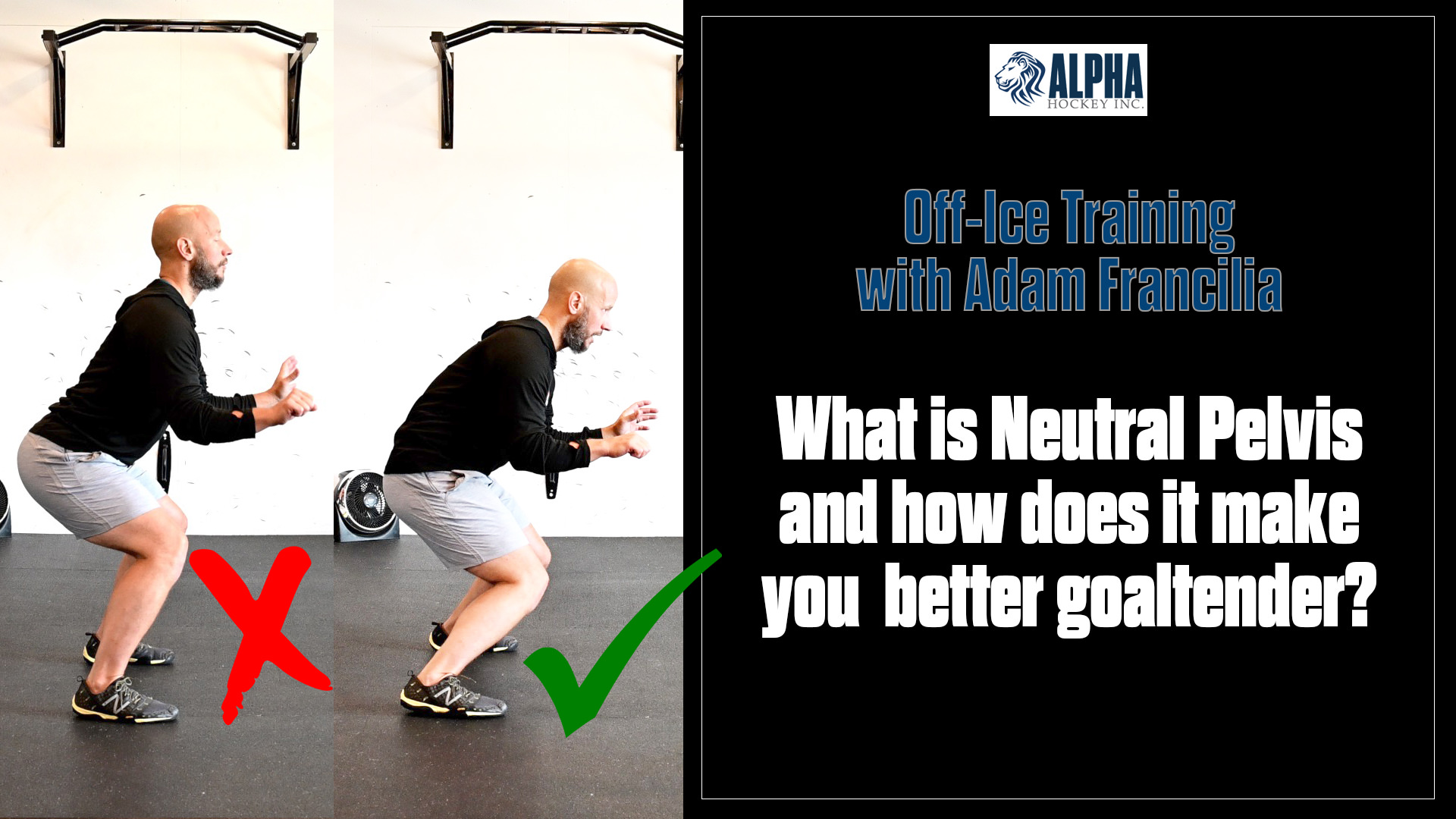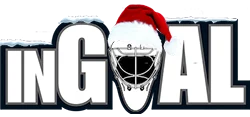
Imagine one change you could make that would make a massive difference in nearly every aspect of your game. You’d move more effectively and more powerfully. You would have better balance and have access to more pucks, more efficiently. You would seal the ice better. You would protect your hips and your back. Even your reads would be more effective. Would you be willing to take a few minutes to learn about and eventually implement that change?
The neutral pelvis has the potential to do all that – and we’ve got a great video from Adam Francillia for our Members that will begin to unlock the possibilities and what they can mean for your game.
Neutral pelvis is a term we have begun to hear more and more recently — but here at InGoal we’ve seen Francillia teaching it to pro goaltenders for many years now. When we stopped by his studio this summer (don’t worry, the camera is more than six feet away!) he took some time to demonstrate exactly what he means by neutral pelvis and we are excited to share it with you today.
Engage with your learning
Typically when we share one of Adam’s videos with you we suggest you watch it all before trying the exercise. This one is different. You will probably want to watch it several times and while you do we encourage you to stop it frequently, try what he is demonstrating, get a feel for what is happening and how it affects your stance and movement. There is no better way to learn than to engage with your learning — and that means getting involved with this demonstration. You’ll want to work with it off the ice and really begin to understand what is being taught before you try to put it into your game.
Taking it on the ice
As with everything Adam teaches us, the goal is to tie your off-ice development and neuromuscular patterns into what you do on the ice. There’s a lot to learn today and it won’t become second nature without a lot of repetitions. So take some time when you’re on the ice, whether it’s warming up before practice or between reps or any other time you can grab some time and try to see how this applies when you get into your gear. See if you can feel what you have learned in a simple static situation — taking your stance, for example. Then see if you can apply it to some butterfly drops or some simple crease movements. Make it a habit to try these things every session and with time you will find it becoming a part of your game.
The Video
With those points in mind, take some time to work through the video now.
As promised there is a tonne to digest here.
As Francillia notes, a stance we often see in goaltenders with an anterior pelvic tilt that often comes from trying to hard to have a straight back — we are so often told to straighten our backs to protect them — can actually have the exact opposite effect than what we want. The key muscles of the glutes and abdominal wall are turned off. It jams up our lumbar spine (lower back) and our hip flexors. Lengthened muscles while we are in extension are less effective and actually more vulnerable to injury.
But when we work towards the neutral pelvis with more of a posterior tilt that all changes and we protect our hips and our back — all while becoming more efficient and effective in our stance and movements. It will eliminate delay as we move towards the ice ensuring our response to our reads is correct.
How often have you had one of those practices where nothing seems to go right? You get beat, you make some adjustments to the feedback you are feeling and you get beat again. It can spiral into what feels like an endless cycle no matter what you do. In the rifle and scope analogy Francillia comments on one small aspect of the neutral pelvis that is actually a significant lesson for us in so many more situations. In other words, when things aren’t going well you may feel like your reads or your positioning or your save selections are wrong, when in fact a different error is leading to all the wrong feedback.
In this case he’s referring to the delay getting to the ice caused by the anterior pelvic tilt makign you think you are leaving too late. But the same applies to countless other situations: The goaltender who is beaten glove side too often may change his glove position when in fact he is simply off angle. The goaltender who is beaten on the back door too often starts to lunge and go early when in fact he just needed better rotation from proper mechanics. Of course one mistake or cheat opens something else up for skilled shooters.
So experiment with the neutral pelvis and see how it affects your game. It has potential to help with more than you might imagine. Be patient and work at it. Remember Francilia’s words:
“Goaltending is a position of perfection, unlike any other position on the ice, it is a position of perfection. So the amount of detail, the amount of precision we must have in our execution has to be spot on and pelvic angle makes a huge difference.”
Want more great off-ice knowledge from Adam Francilia? Check out his counter-rotation series including Horse Stance Dynamic 90-degrees, single leg kneeling abduction, the supine lateral ball roll, the prone lateral ball roll, and the tube hold and the single leg rotation hold. Together the exercises can make up a 30-minute core workout done as part of your regular off-ice training.
If you’d like to learn more about counter-rotation, a great place to start is Carter Hart’s excellent pro-read where he calls himself out for making this common error that causes delay in movement that will also challenge your ability to remain square as you push to move laterally.
Please also check out some exercises from Adam Francilia that will support you in desperation mode, including the swing leg pushup and a one-arm pushup designed with goaltenders in mind. You should also try the Swiss Ball Groin Buster.
For those who missed our introduction to Francilia in earlier articles, a quick refresher: He jumped into the NHL spotlight for the off-ice transformation in 2017 that “helped propel Winnipeg Jets No. 1 Connor Hellebuyck to a Vezina Trophy nomination in 2018, but was working with goalies like James Reimer long before the NET360 camp, where we first me, started in 2015. His current client list includes more than a dozen other NHL-contracted goalies like Reimer, Devan Dubnyk, Matt Murray, Laurent Brossoit, Eric Comrie, Thomas Greiss and Troy Grosenick.
Become a Member to Read the Full Article
We’re working hard to bring you the best exclusive goaltending content whether you play goal, you are a coach, a parent of a goaltender, or a fan of the greatest position in sports.
All InGoal Premium members enjoy an ad-free experience.
Already a member? Log in
15-minute video about one of the most important changes you can make in your game . . .
This content is restricted to InGoal Members only. Please register for an account to view.




Very good. Lots to digest here.
Amazing topic which I feel doesn’t get addressed enough! Curious to hear your opinion on how to ensure we are training properly to support the correct pelvic position… I’m currently trying to incorporate the proper position into my front back squats, deadlifts, bent over rows etc… Advice or quick tips call concerning those movements?
Thank You Thank You Thank You !!!
I first heard about the neutral pelvis on an in goal podcast. I tried it the next time I was on the ice. The results were immediate. My reads and tracking improved, I was faster to my save spots giving me more time before reacting to the shot, over my skates and gliding better, and moving with ease. The video helped explain it in detail. Can’t wait to get back on the ice and learn more on this concept.
It’s a game changer…
Hey Derrick, thanks for your question.
We have to be very careful to understand what application the Neutral/Posterior Pelvic Tilt is used for and when it is not.
As a rule, when we’re using load bearing exercises such as Back/Front Squats, Deadlifts and Bent Over Rows, we do not want to use the Posterior Pelvic Tilt. Doing so can aggravate the lumbar spine and sacrum. When using such exercises, it’s important to maintain a more traditional lifting posture (slight Anterior Pelvic Tilt).
I hope that helps clarify things for you.
Let me know if you have any other questions!
Amazing !!! Thank you kindly for the info good sir. I will maintain my current posture when performing those compound weighted movements. I think I will try and incorporate the proper pelvic twist into my off ice work concerning my stance and recovery positions. With enough reps it should become my default when dropping into my stance on the ice. I’d mention practise but as a 37 year old still hanging around multiple high level men’s leagues… I don’t get much of that LOL
Thanks again, I’ve incorporated every movement you have brought to the table through this series of articles into my off ice work. Truly appreciate the insight you and InGoal Mag are sharing with us 🙂
Adam, thank you for this…really appreciate the detailed explanation you provided. After watching this I then turned to watching a few pro goalies in action and at least the good ones I watched could be seen executing the slight posterior pelvic tilt. It makes tons of sense and visually I can understand the improved efficiency when dropping into butterfly. I have since only just started experimenting with it and after doing some visual practice in the gym with mirrors, I tried it on the ice and I must say it feels dynamic and effortless. As with anything, being aware of something mechanical reveals whether it’s familiar to you or not. It is definetly not familiar, which means I wasn’t doing it. My question is, what mental cues have you found effective in getting your athletes to adapt to this position consistently and easily? I have been trying to use the cue of ‘pulling my navel toward my spine’ and that seems to work initially. Just curious what cues you have used and whether you have any watch outs! thanks again.. very well done!
Hi Don. First off, thank you for your positive comments on the video.
Building in various mental cues is definitely important when attempting to download new information into our brain and nervous system.
One cue that I have used with my goalies that seems to help is imagining yourself getting into a “grappling” position.
When grapplers prepare to fight, they typically assume a fairly rounded spinal posture from tailbone right up to their cervical spine. Their hands are in front and relaxed, not tense. Their weight is on the middle to front of the foot and the biggest key is that they create this shape in a fully balanced form.
When you look at the picture of me in the article (the one with the green checkmark) you can see that I resemble a grappler’s ready stance, except that my feet are parallel and not staggered,,,,,and my hands are open.
So perhaps try standing in front of a mirror and getting into your version of a “goalie grappler” stance. That will give you a nice mental picture and help you to settle into your stance more naturally.
Let me know if that makes sense and works for you!
Adam, Great video and explanation. I can honestly say I learned an incredible amount here and can instantly direct my goalies to head here to watch this for a much more indepth explanation than I will be able to give initially.
One piece I noted was when you talked about the femoral head and the tightness around the hips when in the incorrect position. I am curious on this. Is there any link at all to hip injury sustained by many goalies, especially over time? As Hip Labral tears continue to become more commonly diagnosed, this simple change in stance mechanics would add up to much less stress and load over time. Perhaps a much larger topic for discussion. As I have had to stop playing the position currently due to hip injury, it does make sense.
On another note, many goalies that I work with will be in their stance for a short period (and in the B-Fly) during a drill. During the drill ( 30sec – 1 min) they will often have to stand tall and stretch the lower back. Would working with my goalies in an off ice session on this for short periods of time improve this condition? It would seem like it would to me, so just curious. How often would you recommend this exercise be done over say a 2 – 4 week period ?
Thanks again, really enjoying your videos and always learning.
Take Care.
Awesome video Adam. Great info that I will be sure to incorporate on the ice. I know that some of us, me included, have a naturally pronounced anterior pelvic tilt, which can lead to other problems in the body like hip flexor and low back tightness. I understand that you recommend goalies to set up in a posterior tilt when they get into their stance, but do you have any recommendations on exercises that corrects anterior pelvic tilt?
Watched video, tried my best to reset stance as described and definitely felt faster dropping into BF. Pretty sure I made at least three saves by being faster with this.
How much in your opinion does head position matter? I know when the head position is down the head weighs significantly more. This video was great. The neutral pelvis as you said really opens up the hands for the goalies allowing them to be more effective.
This technique really helped me on the ice! Thank you so much! I was just wondering if Connor Hellebuyck uses neutral pelvis because Adam has worked with him
Hi Adam! Great video. My question is about the trapezius muscles. They’re used to facilitate rotation and connection of the upper body/hands when repositioning or even making stick saves in your butterfly. Are they activated (turned on, loaded, engaged) in the stance position like the glutes, abs, adds are? If so..any tips or “feels” you can give me?
Or the lats.